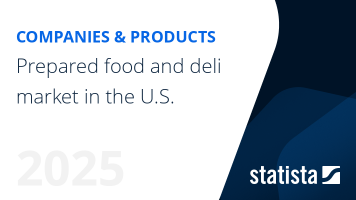To satisfy consumer demand for fresh products, ever-increasing numbers of retailers are presenting large deli departments in their stores. The importance of the deli foods industry is growing; it covers categories such as prepared foods, meat, cheese, and beverages. Often, a fresh bakery section is included. The concept behind deli departments originally started in Germany as early as the 1700s, with retail establishments offering exotic fruits and imported prepared foods to customers referred to as 'Delicatessen'. European immigration to the United States brought along the concept of delicatessen in the 19th century, before the abbreviated version of the name 'deli' gained popularity in the country.
Since the first-ever deli opened in New York in the 1880s,
total deli department sales in the United States have since grown considerably and in 2020, exceeded 41 billion U.S. dollars, almost double the sales figure of 24.3 billion less than a decade earlier in 2014.
Segments
In terms of segments, deli prepared deli foods and deli meals captured the highest
share of deli department sales. With almost half of the sales share, it was the most popular deli segment in the United States in 2021. That year, deli cheese and deli meat were also notable segments within deli departments in the country, accounting for a sales share of 20.2 and 19.3 percent, respectively. Within the biggest deli segment for prepared foods and meals, the categories capturing the biggest sales share were
deli entrees, deli prepared meats, and deli salads.
Deli departments in U.S. supermarkets
While delis have originally started as delicatessen standalone retail establishments, over time many supermarkets and grocery stores in the United States have incorporated deli departments and expanded them. Deli prepared foods had the third-largest
share of perimeter food sales in supermarkets in the U.S. after produce and meat. In the next years, perimeter food sections in supermarkets, including deli departments, are bound to gain more prominence as consumers increasingly turn towards healthier food consumption and reduce consumption of packaged and processed food options.
This text provides general information. Statista assumes no
liability for the information given being complete or correct.
Due to varying update cycles, statistics can display more up-to-date
data than referenced in the text.



































